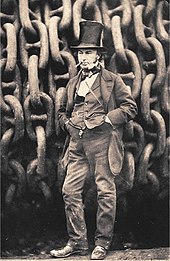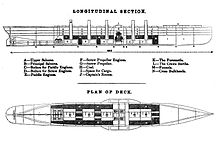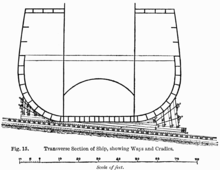SS Great Eastern
 Great Eastern at Heart's Content after laying the first transatlantic cable, July 1866 | |
| History | |
|---|---|
| Name | Great Eastern |
| Port of registry | Liverpool, United Kingdom |
| Ordered | 1853 |
| Builder | J. Scott Russell & Co., Millwall |
| Laid down | 1 May 1854 |
| Launched | 31 January 1858 |
| Completed | August 1859 |
| Maiden voyage | 30 August 1859 |
| In service | 1859 |
| Out of service | 1889 |
| Stricken | 1889 |
| Homeport | Liverpool |
| Nickname(s) |
|
| Fate | Scrapped 1889–90 |
| Notes | Struck rocks on 27 August 1862. No bigger ship in all respects until 1913. |
| General characteristics | |
| Type | Passenger ship |
| Tonnage | 18,915 GRT[2] |
| Displacement | 32,160 tons |
| Length | 692 ft (211 m) |
| Beam | 82 ft (25 m) |
| Decks | 4 decks |
| Propulsion | Four steam engines for the paddles and an additional engine for the propeller. Total power estimated at 8,000 hp (6,000 kW). Rectangular boilers[1] |
| Speed | 14 knots (26 km/h; 16 mph)[3] |
| Boats & landing craft carried | 18 lifeboats; after 1860 20 lifeboats |
| Capacity | 4,000 passengers |
| Complement | 418 |
SS Great Eastern was an iron sail-powered, paddle wheel and screw-propelled steamshipdesigned by Isambard Kingdom Brunel, and built by John Scott Russell & Co. at Millwall Iron Works on the River Thames, London. She was the largest ship ever built at the time of her 1858 launch, and had the capacity to carry 4,000 passengers from England to Australia without refuelling. Her length of 692 feet (211 m) was surpassed only in 1899 by the 705-foot (215 m) 17,274-gross-ton RMS Oceanic, her gross tonnage of 18,915 was only surpassed in 1901 by the 701-foot (214 m) 20,904-gross-ton RMS Celtic and her 4,000-passenger capacity was surpassed in 1913 by the 4,234-passenger SS Imperator. The ship having five funnels (which were later reduced to four) was unusual for the time. The vessel also had the largest set of paddle wheels.
Brunel knew her affectionately as the "Great Babe". He died in 1859 shortly after her maiden voyage, during which she was damaged by an explosion.[4] After repairs, she plied for several years as a passenger liner between Britain and North America before being converted to a cable-laying ship and laying the first lasting transatlantic telegraph cable in 1866.[5] Finishing her life as a floating music hall and advertising hoarding (for the department store Lewis's) in Liverpool, she was broken up on Merseyside in 1889.
History[edit]
Concept[edit]
After his success in pioneering steam travel to North America with Great Western and Great Britain, Brunel turned his attention to a vessel capable of making longer voyages as far as Australia. With a planned capacity of 15,000 tons of coal, Great Eastern was envisioned as being able to sail halfway around the world without taking on coal, while also carrying so much cargo and passengers that papers described her as a "floating city" and "the Crystal Palace of the sea".[6][7] Brunel saw the ship as being able to effectively monopolize trade with Asia and Australia, making regular trips between Britain and either Trincomalee or Australia.[7]
On 25 March 1852, Brunel made a sketch of a steamship in his diary and wrote beneath it: "Say 600 ft x 65 ft x 30 ft" (180 m x 20 m x 9.1 m). These measurements were six times larger by volume than any ship afloat; such a large vessel would benefit from economies of scale and would be both fast and economical, requiring fewer crew than the equivalent tonnage made up of smaller ships. Brunel realised that the ship would need more than one propulsion system; since twin screws were still very much experimental, he settled on a combination of a single screw and paddle wheels, with auxiliary sail power. Although Brunel had pioneered the screw propeller on a large scale with Great Britain, he did not believe that it was possible to build a single propeller and shaft (or, for that matter, a paddleshaft) that could transmit the required power to drive his giant ship at the required speed.[8]
Brunel showed his idea to John Scott Russell, an experienced naval architect and ship builder whom he had first met at the Great Exhibition. Scott Russell examined Brunel's plan and made his own calculations as to the ship's feasibility. He calculated that it would have a displacement of 20,000 tons and would require 8,500 horsepower (6,300 kW) to achieve 14 knots (26 km/h; 16 mph), but believed it was possible. At Scott Russell's suggestion, they approached the directors of the Eastern Steam Navigation Company with the new design plan. The James Watt Company would design the ship's screw, Professor Piazzi Smyth would design its gyroscopic equipment, and Russell himself would build the hull and paddle wheel.[7]
1854–1859: Construction to launch[edit]
Construction[edit]
Brunel entered into a partnership with John Scott Russell, an experienced naval architect and ship builder, to build Great Eastern. Unknown to Brunel, Russell was in financial difficulties. The two men disagreed on many details. It was Brunel's final great project, and he collapsed from a stroke after being photographed on her deck, and died only ten days later, a mere four days after Great Eastern's first sea trials. About the ship, Brunel said "I have never embarked on any one thing to which I have so entirely devoted myself, and to which I have devoted so much time, thought and labour, on the success of which I have staked so much reputation."
Great Eastern was built by Messrs Scott Russell & Co. of Millwall, London, the keel being laid down on 1 May 1854. She was 211 metres (692 ft 3 in) long, 25 metres (82 ft 0 in) wide, with a draught of 6.1 metres (20 ft 0 in) unloaded and 9.1 metres (29 ft 10 in) fully laden, and displaced 32,000 tons fully loaded. In comparison, SS Persia, launched in 1856, was 119 m (390 ft 5 in) long with a 14 m (45 ft 11 in) beam. She was at first named Leviathan, but her high building and launching costs ruined the Eastern Steam Navigation Company and so she lay unfinished for a year before being sold to the Great Eastern Ship Company and finally renamed Great Eastern. It was decided she would be more profitable on the Southampton–New York run, and she was outfitted accordingly.[9]
The hull was an all-iron construction, a double hull of 19-millimetre (0.75 in) wrought iron in 0.86 m (2 ft 10 in) plates with ribs every 1.8 m (5 ft 11 in). Her roughly 30,000 iron plates weighed 340 kilograms (1⁄3 long ton) each, and were cut over individually-made wooden templates before being rolled to the required curvature.[7] Internally the hull was divided by two 107 m (351 ft 1 in) long, 18 m (59 ft 1 in) high, longitudinal bulkheads and further transverse bulkheads dividing the ship into nineteen compartments. Great Easternwas the first ship to incorporate a double-skinned hull, a feature which would not be seen again in a ship for 100 years, but which would later become compulsory for reasons of safety. To maximize her fuel capacity, stored coal was bunkered around and over her 10 boilers.[7] She had sail, paddle and screw propulsion. The paddle-wheels were 17 m (55 ft 9 in) in diameter and the four-bladed screw-propeller was 7.3 m (23 ft 11 in) across. The power came from four steam engines for the paddles and an additional engine for the propeller. Total power was estimated at 6,000 kilowatts (8,000 hp). She had six masts (said to be named after the days of a week – Monday being the fore mast and Saturday the spanker mast), providing space for 1,686 square metres (18,150 sq ft) of sails (7 gaff and maximum 9 (usually 4) square sails), rigged similar to a topsail schooner with a main gaff sail (fore-and-aft sail) on each mast, one "jib" on the fore mast and three square sails on masts no. 2 and no. 3 (Tuesday & Wednesday); for a time mast no. 4 was also fitted with 3 yards. In later years, some of the yards were removed. According to some sources she would have carried 5,435 m2 (58,500 sq ft) in sails.[who?] Setting sails turned out to be unusable at the same time as the paddles and screw were under steam, because the hot exhaust from the five (later four) funnelswould set them on fire. Her maximum speed was 13 knots (24 km/h; 15 mph). She was involved in a series of accidents during construction, with 6 workers being killed.[10]
Launch[edit]
Great Eastern was planned to be launched on 3 November 1857. The ship's massive size posed major logistical issues; according to one source, the ship's 19,000 tons (12,000 inert tons during the launch) made it the single heaviest object moved by humans to that point.[9] On 3 November, a large crowd gathered to watch the ship launch, with notables present including the Comte de Paris, the Duke of Aumale, and the Siamese ambassador to Britain.[9] The launch, however, failed, and the ship was stranded on its launch rails – in addition, two men were killed and several others injured, leading some to declare Great Eastern an unlucky ship. Brunel rescheduled the launch for January 1858, hoping to use the tide in the next launch attempt.[9]
In the leadup to the second launch, Brunel and Great Eastern's backers gathered a significant number of chains, jacks, hydraulic rams, and windlasses to assist in launching the ship. Some were obtained from sympathetic engineers, others through returned favours, and yet more for increasing sums of money; so lucrative was renting out of supplies for the ship's launch that engineer Richard Tangye was able to found his own engineering firm (Tangye & Co) the next year, remarking that "We launched Great Eastern, and she launched us".[9] Advice sent to Brunel on how to launch the ship came from a number of sources, including steamboat captains on the Great Lakes and one admirer who wrote an insightful description on how the massive Bronze Horseman had been erected in Saint Petersburg.[9] High winds prevented the ship from being launched on 30 January, but the next morning a fresh attempt successfully launched the ship around 10:00 in the morning.[9]
Following her launch, Great Eastern spent a further 8 months being fitted out. However, the cost of the fitting out ($600,000) concerned many investors, who had already spent nearly $6,000,000 constructing her.[11] With the building company already in debt, cost cutting measures were implemented; the ship was removed from Russell's shipyard, and many investors requested she be sold. As reported by the Times, one investor openly proposed that the ship be sold to the Royal Navy, noting if the navy employed Great Eastern as a ram, she would easily cleave through any warship afloat.[11] These efforts had mixed success, with the ship eventually being sold to a new company for £800,000, equating to a loss of $3,000,000 for investors in the Eastern Steam Navigation Company.[4]The new company modified parts of its predecessor's design, most notably cutting the ship's coal capacity as it intended to use the ship for the American market. Fitting out concluded in August 1859 and was marked with a lavish banquet for visitors (which included engineers, stockholders, members of parliament, 5 earls, and other notables).[4] In early September 1859, the ship sailed from her dock towards the channel, accompanied by many spectators. However, off Hastings she suffered a massive steam explosion (caused by a valve being left shut by accident after a pressure test of the system) that killed five men.[4] She proceeded to Portland Bill and then to Holyhead, though some investors claimed more money could have been made if the ship had remained as an "exhibition ship" for tourists in the Thames.[4] Great Eastern successfully rode out the infamous Royal Charter Storm, after which it was moved to Southampton for the winter.[4] The start of 1860 led to a further change of ownership when the owning company was found to be badly in debt and the value of the ship depreciated by half. This revelation forced the resignation of the board of directors, who were then replaced by a third group of controlling stockholders.[4]
With the new board in place, the ship was recapitalized to raise an additional $50,000. The new board was determined to finish the ship, but also betted heavily on making large profits exhibiting the ship in North American seaports. To accomplish this, the company played major American and Canadian cities against each other, goading them into competition over which city would welcome Great Eastern; the city of Portland, Maine (with additional investment from the Grand Trunk Railroad) went so far as to build a $125,000 pier to accommodate the ship.[12] Ultimately New York City – which had quickly dredged a berth for her alongside a lumber wharf – was decided on as the ship's first destination.[12]





